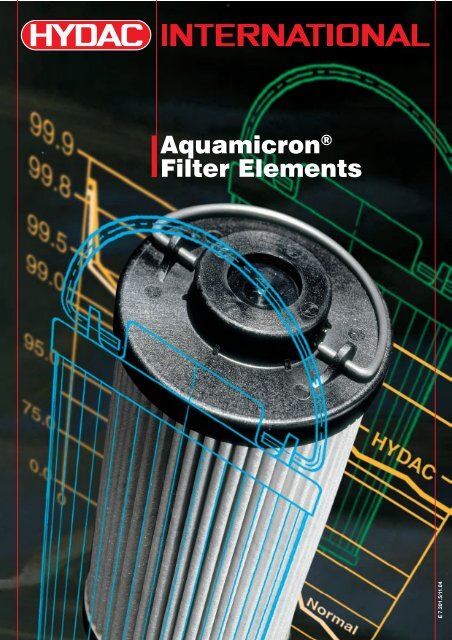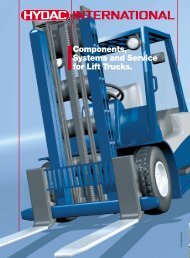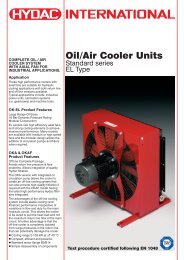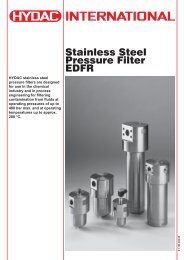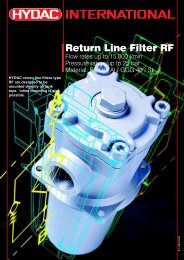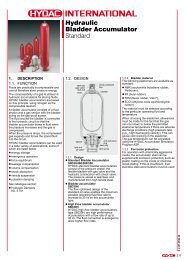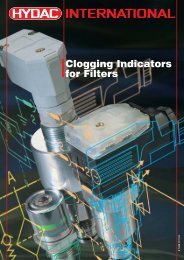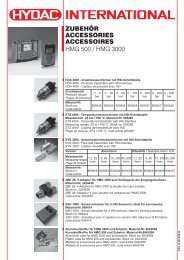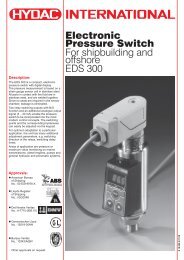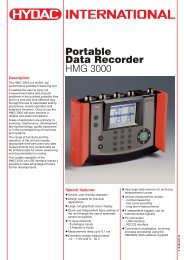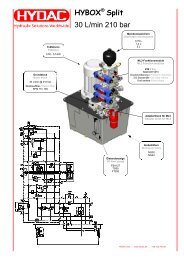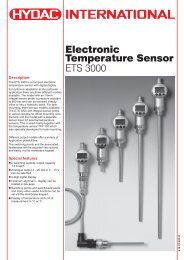Aquamicron® Filter Elements - Hydac
Aquamicron® Filter Elements - Hydac
Aquamicron® Filter Elements - Hydac
You also want an ePaper? Increase the reach of your titles
YUMPU automatically turns print PDFs into web optimized ePapers that Google loves.
Aquamicron ®<br />
<strong>Filter</strong> <strong>Elements</strong><br />
E 7.201.5/11.04
1. DESCRIPTION<br />
The presence of water in<br />
hydraulic media causes many<br />
problems, for example, the<br />
saturation of very fine filters or<br />
jamming of valves, and these<br />
problems are often wrongly<br />
attributed to excessive levels of<br />
solid particle contamination.<br />
In addition to this the build-up of<br />
rust and the reduction in<br />
lubrication on bearings and slides<br />
can lead to considerable<br />
impairment in the functioning of a<br />
system. In other words, water is<br />
a serious "contaminant" of a<br />
hydraulic medium.<br />
Since methods usually employed<br />
up to now to extract water have,<br />
on the whole, proved to be<br />
uneconomical compared to the<br />
purchase price of a system,<br />
HYDAC Aquamicron ® technology<br />
offers an economically sound, yet<br />
effective, method of separating<br />
water from hydraulic media.<br />
Aquamicron® filter elements are<br />
specially designed to separate<br />
water from mineral oils, HFD-R<br />
oils and biodegradable oils.<br />
They are only available in the<br />
dimensions of the HYDAC HC<br />
return line filter elements from<br />
size 330 upwards. This means<br />
that they can be installed in all<br />
HYDAC filter housings from size<br />
330/331 upwards, which are fitted<br />
with return line filter elements.<br />
The increasing pressure loss in a<br />
filter element which is being<br />
saturated with water indicates,<br />
by means of standard clogging<br />
indicators, that it is time to change<br />
the element. When Aquamicron ®<br />
technology is employed, solid<br />
particle contaminants are also<br />
separated from the hydraulic<br />
medium as a side-effect.<br />
This means that the Aquamicron ®<br />
element doubles as a safety filter.<br />
The "filtration rating" is<br />
40 µm absolute (β 40<br />
≥100 to<br />
∆p = 3 bar). In order to guarantee<br />
greatest efficiency it is<br />
recommended that they are<br />
installed off-line.<br />
Note:<br />
The Aquamicron ® elements are<br />
disposable items.<br />
1.1. PRINCIPLES OF AQUAMICRON ® TECHNOLOGY<br />
The separation of water from hydraulic fluids with the aid of the super<br />
absorber embedded in the filter material is based on a physical-chemical<br />
reaction. The super absorber reacts with the water present in the medium<br />
and expands to form a gel, from which the water present in the medium can<br />
no longer be extracted even by increasing the pressure.<br />
The Aquamicron ® technology is capable of absorbing circulating water, be it<br />
emulsified or free. These filter elements cannot remove dissolved water from<br />
the system, i.e. water below the saturation level of the hydraulic medium.<br />
The following principles apply to Aquamicron ® technology:<br />
High water content ⇒ High absorption rate<br />
Low water content ⇒ Low absorption rate<br />
Unsaturated filter element ⇒ High absorption rate<br />
Saturated filter element ⇒ Low absorption rate<br />
Hydraulic Absorption rate <br />
filter area load Water retention capacity <br />
(l/min cm²) Residual water content <br />
Static pressure Absorption rate =<br />
Water retention capacity =<br />
Residual water content<br />
<br />
Pressure and flow-rate Absorption rate <br />
fluctuations present Water retention capacity <br />
Residual water content<br />
<br />
Dispersion/detergent Absorption rate <br />
additive present Water retention capacity =<br />
Residual water content<br />
<br />
Key to symbols: increases decreases = constant<br />
2. GENERAL<br />
Max. permissible operating<br />
pressure<br />
25 bar<br />
Max. permissible ∆p<br />
across element<br />
10 bar<br />
Temperature range<br />
0 °C to +100 °C<br />
Compatibility with hydraulic<br />
media<br />
Mineral oils:<br />
test criteria to ISO 2943<br />
Lubricating oils:<br />
test criteria to ISO 2943<br />
Other media on request<br />
Cracking pressure of the<br />
bypass valve<br />
∆p o<br />
= 3 bar +10%<br />
Bypass valve curves<br />
The bypass valve curves apply<br />
to mineral oils with a density of<br />
0.86 kg/dm 3 . The differential<br />
pressure of the valve changes<br />
proportionally to the density.<br />
∆p in bar<br />
A: Sizes: 0500 R ...<br />
0850 R ...<br />
2600 R ...<br />
B: Sizes: 0330 R ...<br />
0660 R ...<br />
1300 R ...<br />
C: Sizes: 0950 R ...<br />
Q in l/min as a percentage of the size<br />
E 7.201.5/11.04<br />
2
3. MODEL CODE<br />
Size<br />
0330<br />
0500<br />
0660<br />
0850<br />
0950<br />
1300<br />
2600<br />
Type<br />
R<br />
(also order example)<br />
Filtration rating in µm<br />
040 absolute<br />
<strong>Filter</strong> material<br />
Aquamicron ®<br />
Supplementary details<br />
–V FPM (-Viton) seal<br />
0660 R 040 AM /-V<br />
4. ELEMENT<br />
SPECIFICATIONS<br />
4.1. FILTRATION AREA<br />
Size<br />
cm²<br />
0330 2785<br />
0500 4259<br />
0660 6174<br />
0850 7949<br />
0950 8667<br />
1300 12111<br />
2600 24711<br />
5. DETERMINATION OF THE WATER CONTENT G W<br />
PRESENT IN THE SYSTEM<br />
Two methods can be employed to determine the water content G W<br />
present in<br />
the system:<br />
– the hydrogen gas method<br />
– the Karl Fischer method to DIN 51777<br />
The hydrogen gas method can be carried out using portable test equipment,<br />
e.g. the HYDAC Water Test Kit WTK; however, reading accuracy at water<br />
contents below 500 ppm is limited.<br />
The Karl Fischer method, on the other hand, can only be conducted in the<br />
laboratory. It is available from HYDAC Filtration Technology as a laboratory<br />
service.<br />
The water content G W<br />
is usually given in ppm (parts per million) or in percent<br />
(100 ppm corresponds to 0.01 %).<br />
6. CALCULATION<br />
6.1. DETERMINATION OF<br />
THE WATER RETENTION CAPACITY C W (cm³)<br />
q = Q (Recommendation: q max ≤ 0.04 l/min cm²)<br />
A<br />
q = specific filtration area load of a filter element in l/min cm²<br />
Q = flow rate in l/min<br />
A = filtration area in cm² (point 4.1)<br />
Specific water retention capacity<br />
K W (10 -3 cm³ H 2<br />
O/cm²)<br />
Viscosity: 30 mm²/s<br />
Density: 0.86 kg/dm³<br />
C W<br />
C W<br />
K W<br />
Recommended application range<br />
Uneconomical application range<br />
= K W x A (cm³)<br />
= water retention capacity of a filter element in cm³<br />
= specific water retention capacity dependent on the specific<br />
filtration area load q in (10 -3 cm³ H 2<br />
O/cm²)<br />
A = filtration area in cm² (see point 4.1.)<br />
q = specific filtration area load of a filter element in l/min cm²<br />
Specific filtration<br />
area load<br />
q (l/min x cm²)<br />
E 7.201.5/11.04<br />
3
6.2. AQUAMICRON ® ELEMENT SIZE<br />
RECOMMENDATIONS<br />
Size Recommended Water retention Part no.<br />
flow rate capacity C W in cm³ at<br />
in l/min ∆p = 2.5 bar and an oil<br />
viscosity of 30 mm²/s<br />
0330 13 advised 260 315268<br />
100 maximum 180<br />
0500 19 advised 400 315355<br />
155 maximum 280<br />
0660 28 advised 570 315356<br />
255 maximum 400<br />
0850 35 advised 730 315357<br />
286 maximum 520<br />
0950 39 advised 800 315358<br />
314 maximum 570<br />
1300 54 advised 1120 315269<br />
437 maximum 790<br />
2600 109 advised 2230 316102<br />
870 maximum 1570<br />
6.3. CALCULATION OF THE WATER QUANTITY m W<br />
TO BE ABSORBED BY THE FILTER ELEMENT<br />
m W = ∆G W x 10 -3 x V T (cm³)<br />
m W = water quantity to be absorbed by<br />
the filter element in cm³<br />
∆G W = difference between the initial and required<br />
final water content in ppm<br />
Please note:<br />
It is impossible to achieve a final water<br />
content below the saturation level of<br />
the hydraulic medium!<br />
V T = tank volume in litres x 1000<br />
6.4. CALCULATION OF THE NUMBER<br />
OF ELEMENTS REQUIRED<br />
n = m W<br />
C W<br />
n = number of filter elements required<br />
The economical use of Aquamicron ®<br />
technology depends on the cost of<br />
filter elements compared to the cost of<br />
buying and disposing of the oil.<br />
m W = water quantity to be absorbed by<br />
the filter element in cm 3 (see point 6.3.)<br />
C W = water-retention capacity of a filter element<br />
in cm 3 (see point 6.1.)<br />
E 7.201.5/11.04<br />
7. NOTE<br />
The information in this brochure relates to the<br />
operating conditions and applications described.<br />
For applications or operating conditions not<br />
described, please contact the relevant technical<br />
department.<br />
Subject to technical modifications.<br />
E 7.201.5/11.04


